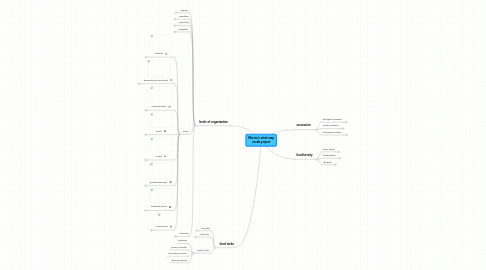
1. levels of organization
1.1. organism
1.1.1. any form of life
1.2. population
1.2.1. group of induviduals of the same species found in a given area or located in the same area at a given time
1.3. community
1.3.1. populations of a living organim benefits while the other is not affected
1.4. ecosystem
1.4.1. group of living organisms that interact with one another and the non living physical enviornment as one unit
1.5. biome
1.5.1. rainforest
1.5.1.1. a forest with heavy annual rainfall.
1.5.2. temperate deciduous forest
1.5.2.1. a biome found in the eastern and western United States, Canada, central Mexico, South America, Europe, China, Japan, North Korea, South Korea and parts of Russia.
1.5.3. coniferous forest
1.5.3.1. A forest consisting mostly of conifers such as firs, pines and spruces, usually in climates too dry or too cold to support deciduous forest.
1.5.4. desert
1.5.4.1. A dry, barren area of land, esp. one covered with sand, that is characteristically desolate, waterless, and without vegetation
1.5.5. Tundra
1.5.5.1. A vast, flat, treeless Arctic region of Europe, Asia, and North America in which the subsoil is permanently frozen
1.5.6. grassland/savannah
1.5.6.1. ecosystem characterized by the trees being sufficiently small or widely spaced so that the canopy does not close.
1.5.7. fresh water biome
1.5.7.1. water containing fewer salts than the waters in the marine biome; divided into two zones: running waters (rivers, streams) and standing waters (lakes, ponds).
1.5.8. marine biome
1.5.8.1. includes all the water that is on the earth's surface. The marine biome covers three fourths of the earth.
1.6. biosphere
1.6.1. The regions of the surface and atmosphere of the earth or other planet occupied by living organisms.
2. food webs
2.1. food web
2.1.1. a system of food chains
2.2. food chain
2.2.1. organisms each dependent on the next as a source of food
2.3. Trophic levels
2.3.1. producers
2.3.2. primary consumer
2.3.3. secondary consumer
2.3.4. tertiary consumer
3. succession
3.1. ecological succession
3.1.1. the gradual and orderly process of change in an ecosystem brought about by the progressive replacement of one community by another until a stable climax is established
3.2. primary succesion
3.2.1. Succession beginning with bare rock or soil.
3.3. secondary succession
3.3.1. the process of revegetation of an area that has been cleared for some reason.
4. biodiversity
4.1. biotic factors
4.1.1. the living components of the environment
4.2. abiotic factors
4.2.1. the non living parts of an ecosystem.
4.3. hot spots
4.3.1. areas of high species richness, which are of high priority for protection.
